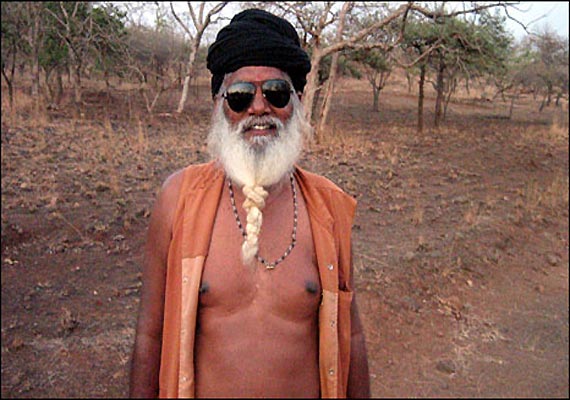Lessons from conservation photographers Cyril Christo and Marie Wilkinson
By
Milene Fernandez,
Epoch Times | April 19, 2014
His voice carries a palpable sense of urgency, “We are in the
eleventh hour!” he says. His passion for life undeniable, “Honoring
life, is more important than any interpretation of life,” Cyril Christo
continues as he shares snippets of his life story, his raison d’être.
The poet, Oscar-nominated filmmaker, wildlife photographer, and son
of the renowned artist-couple Christo and Jeanne-Claude does not care
for fame (he grew up with it) or even for the permanence of his work, he
explains during a phone interview. “If we could stop the ivory trade, I
would burn every [photo] negative tomorrow,” he says. Representations
of wildlife essentially do not matter. He would rather see those animals
thriving in their natural habitat. He writes, photographs, and films to
inspire others in a call to action.
“We have to have a Marshall Plan immediately for how we treat the earth, for utter respect and survival.” About
40,000
African elephants are killed every year—that is, one every 15
minutes—at the hands of poachers. At that rate, elephants could become
extinct within just 10 years.
If only time could be extended so as to fully grasp the rich tapestry
of all the stories Christo begins to tell, but are left trailing. Time
spent in nature in all its plethora of wonder and beauty can leave you
tranquil and amazed. It’s incredibly challenging to be able to
communicate that experience. Christo tries to convey how intricately
interconnected nature is.
Each line of thought could turn into a lengthy poem with a powerful
purpose. Each leads to the same conclusion: respect life. Christo
recounts a lucid dream with words that left a profound impression, “Hold
on to the waters of life.”
Animals signal and warn us of climate change because “they form part
of the immune system of our planet,” he says. Melting arctic ice leaves
polar bears starving to death in their shrinking habitat. With forests
dwindling, some tigers have gone rogue, hunting people instead of
calves, like the so-called
man-eating tiger in India’s Uttar Pradesh and Uttarakhand states in recent months.
There are only about 3,200 tigers left, compared to 100,000 at the
beginning of the 20th century. Only about 15,000 wild lions are left in
Africa, compared to 200,000 just 30 years ago.
Africa’s forest elephant plays a key role in maintaining the second
largest rainforest in the world in the Congo Basin. Those rainforests
are the lungs of earth. The seeds of forest trees can only germinate
after passing through an elephant’s digestive tract. “So we have all
sorts of climactic ramifications with the loss of 80 to 90 percent of
the forest elephant,” Christo says.
What has concerned Christo and conservationists for years is starting
to get through to some world leaders. The Intergovernmental Panel on
Climate Change (IPCC) released a
U.N. report
on March 31 warning that the state of the environment is reaching a
tipping point. The Obama administration says it is taking this new
report as a call for action, with Secretary of State John Kerry saying,
“The costs of inaction are catastrophic.”
That message echoes what Christo learned from Hopi, Navaho, and
Apache elders, who told him that the next five years are crucial. The
year 2020 could be the point of no return. For Christo, that means a
climate bill.
Conservation Power Couple
Christo generates all of his projects with his wife, Marie Wilkinson,
an architect who started taking photographs as a hobby. Their sideline
soon developed into books, films, and campaigns. They vigorously opposed
the ivory trade and protested bad environmental bills put forward in
the Legislature of New Mexico where the couple lives.
They have traveled twice around the world, especially where there are
no electric lights, where more stars can be seen, where the thunderous
roar of lions wakes up your soul, and where indigenous elders have
profound lessons to teach us.
“Slowly we started to entwine,” Wilkinson says. That is evident in
the way they converse with each other—synergistic and full of energy.
“How we got into elephants is because of looking at indigenous people,
how we got into indigenous people is how we were looking at culture and
place. … It became quite clear that different cultures had different
stories that showed an incredible understanding and respect and
connection to the places that they lived,” Wilkinson explains.
Christo elaborates, “Native people have a near mystical understanding
and appreciation of animals. And we have made them, since the French
enlightenment, into almost robotic beings to be dissected and things to
be manipulated.”
Nanfang Daily, a local newspaper in Zhanjian, in China’s Guangdong Province, recently published a shocking
report.
A party of local officials and well-heeled folks had a “fun day” by
electrocuting at least 10 tigers. They called it “visual feast”
entertainment. The tigers’ body parts were then given away as expensive
gifts or sold on the black market.
In sharp contrast, Christo and Wilkinson strive to reverse that
depravity, the popular trend of dominating the forces of nature. As
artists and conservationists, they encourage us to understand and
“incorporate those forces” instead.
In Predatory Light
Reading Christo and Wilkinson’s third and latest book, “In Predatory Light: Lions, Tigers and Polar Bears” (
review)—
one of Amazon’s Top 10 nature and photography titles of 2013—becomes a
visceral, cinematic experience, taking the reader to a place and time
when humans and predators cohabited peaceably. Christo and Wilkinson
call it a truce.
“The lions would go to the water hole at night and the Bushmen would
go drink during the day when it was warm and there would never be
antagonism,” Christo wrote. There is the tale of a tiger in the Gir
forest of India that would regularly hunker down by a sadhu’s temple to
listen to the bell being rung every evening.
Christo and Wilkinson take black and white photographs, they do not
alter them, and they develop their images from celluloid negatives. The
images have a raw beauty to them.
The couple might wait for days or even weeks to photograph a tiger.
“The thing about the tiger is: you can go looking for a tiger, but you
are not going to find a tiger. The tiger is going to choose to reveal
itself,” Wilkinson says. The couple would drive through the woods for
hours and hours through Bandhavgarh National Park in India. Then at the
most unexpected moment a huge, vibrant, tiger would suddenly appear. In
seconds Wilkinson would barely get her camera ready before the tiger
would disappear into the forest—just as quickly as it had appeared.
Describing her encounter, she conveys how predators command respect.
“They look straight at you. It’s like they look into your soul. They are
both knowing and menacing. You don’t mess with them, even if you want
to scratch them behind the ear,” Wilkinson says.
In their natural environment predators are not prone to killing
humans in the way that some humans are prone to killing them for sheer
entertainment or blood money. “We understand now the disorder that we
are living throughout the entire world, that kids are undergoing, is
because we don’t have that millennial relationship with the organic
world,” Christo says.
Traveling Childhood
Christo encountered that organic world at a young age. He grew up
shuttling back and forth across the Atlantic between France, Tunisia,
and New York.
In Paris his family lived near the Guimet Museum, which was full of
Asian artifacts; he lived in a small castle with lots of books in
northern France; in New York City, he lived in a loft with rats running
around and where he played with his father’s paintbrushes; he saw
Bedouins in southern Tunisia, ate couscous, and swam with his favorite
uncle. He called these and other temporary residences “a little bit of
the best of the New World and the Old World.”
When he turned 15, Christo tired of New York City and trekked to
Africa to climb Mount Kenya with other students in an international
exchange program. They started at 10,000 feet and climbed up to 13,000
feet the first day. Christo carried a 40-pound backpack in a downpour
for nine hours through what he calls a “miasma of pure mud and hell.”
The next day they went up to 17,000 feet and survived the first of many,
in his words, “amazing trials.”
He contemplated the volcanic Chyulu hills overlooking Kilimanjaro,
and a parade of elephants going right by his tent. He heard lions
roaring at night. “It’s an acoustic blast summoning you to the beginning
of time,” he recalls. He says that whole experience “moves in your
spirit for the rest of your life.” That experience, bigger than himself,
strengthened Christo’s character, and instilled in him a sense of
purpose.
Despite, or maybe because of, his extraordinary background and
journey growing up, Christo has a humble demeanor. “I wasn’t trained to
do anything, but wanted to verbalize concerns, to try to remind people
how extraordinary the world is,” he says. In some ways he has learned
more from traveling than from his studies at Columbia University where
he felt “a bit discombobulated.”
Lessons From the Elders
Christo and Wilkinson have developed an immense appreciation for
nature in its stark contrast to a world where people think they would be
at a loss without their smartphones and other gadgets, where obesity is
on the rise, and where children spend more time playing video games
than playing outdoors.
They discovered that the Maasai, the semi-nomadic people in Kenya and
Tanzania, do not even have a term for nature because the Maasai don’t
see a separation. They know how to farm in the deserts and scrublands.
Their invaluable survival skills may finally be recognized as a way to
cope with climate change.
Like the Maasai, the Inuit in the Arctic regions understand that
everything is reciprocal. “The life force for the Inuit is also part of
the mind. If you don’t respect the weather, it affects your mind. If you
don’t respect the polar bear, your spirit is upset,” Christo says.
A San Bushman baby of southern Africa receives the name of the first
star seen at the baby’s birth, he says. This close connection to the
cosmos gets lost in an urban environment. In the big city, city lights
wipe out the starlight.
Today, people are unable to see the whole picture. Christo says we
only see bits and pieces of what’s important. “The Samburu elders, who
have their totem called the elephant, said that we [in the modern world]
are interested in body parts.”
People kill tigers for their fur, or claws, teeth, bones, whiskers,
and whatever else to make medicines. Poachers kill elephants for one
relatively small body part: their tusks. The illegal ivory trade fuels
half a billion dollars in annual profit (video:
God’s Ivory).
“What we lost is the association with life. The modern world does not
honor truly anything, to be quite frank. It honors profit and that is
something that is costing the life force itself. We will not be able to
survive without the other beings,” Christo says.
Humans as well as other living beings depend on a survivable
environment. “There’s no amount of money that can supplant a species, an
ecosystem, a river, what the Amazon gives us, the phytoplankton.” It
seems we are stuck in an ethos of scarcity with the false assumption
that profit can only be gained through destruction.
Although the IPCC report, put together by 1,250 experts, gives a grim
assessment, it assures that a climate change catastrophe can be
prevented without sacrificing living standards. If we have the
willpower, we have the capacity and the green technology to turn the
tide. It could even be profitable—in a sustainable way. Secretary of
State Kerry contends that the global energy market represents a $6
trillion opportunity and that investment in the energy sector could
reach nearly $17 trillion by 2035.
But to turn that tide requires concerted action, and that action can
only stem from a broader understanding of nature and ourselves. Christo
recalls, “The Native American elders say, ‘Do not fight against
yourselves, you will have enough to deal with Mother Nature.’”
Climate change will contribute to escalating global security
problems, like strife and fights over resources, like water, the Nobel
Peace Prize-winning
IPCC reports.
“We have to ask ourselves, ‘What kind of relationship do we want?’
because we are creating a society that destroys relationships. … The
alienation is also with those other beings that are not human but that
have an immense amount of things to teach us about who we are,” Christo
says.
Those predators keep us in check. If we eliminate the last predators
on earth, Christo argues humans will be in danger of self-cannibalizing.
“We’ve got to honor existence again or otherwise we won’t even be in
survival mode. We will be in a mode we have to make sure we don’t
strangle each other. We are not thriving,” he adds.
Overcoming Obstacles, Creating for the Future
The immediacy conveyed in Christo’s voice also shows a hint of
anxiety and frustration with the obstacles he’s confronted with. He
calls it an “incredible parochialism of the mass lack of imagination” of
those who are not concerned about climate change. He wants to make sure
the earth will be sustainable for his own son and for the future of all
children.
Christo and Wilkinson are now looking to fund a feature film, titled
“Walking Thunder: The Last Stand of the African Elephant.” They are
dedicating it to their 8-year-old son, Lysander, who learned to walk in
Africa. It will be a personal vision based on their encounters with the
native people of East Africa and the importance of the elephant to the
human condition.
Christo and Wilkinson say, “We are going to go a lot further with
this next film. What does the future of the elephant have to do with the
future of childhood? The answer is: absolutely everything! Civilization
will stand or fall on the back of the African elephant.”
For more information about Cyril Christo and Marie Wilkinson: http://www.christoandwilkinsonphotography.com/
http://www.theepochtimes.com/n3/629074-wildlife-gives-a-wake-up-call-for-our-survival/?photo=2









 PRINT
PRINT









